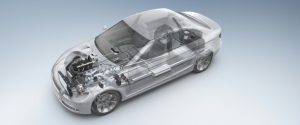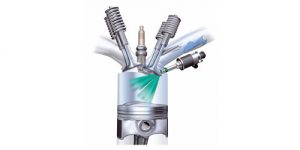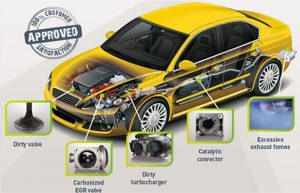Direct fuel injection, also known as GDI in gasoline engines, is a system where fuel is sprayed under high pressure directly into the combustion chamber of each cylinder. GDI is new technology that maximizes power and fuel economy allowing a smaller, lighter engine to provide the same or better performance as larger ones.
WHICH VEHICLES HAVE IT?
 Last December Ward’s Automotive published their “Ten Best Engines” list for 2012. Seven of those engines have gasoline direct fuel injection. These engines ranged from 3.0 to 1.6 liter and were made by Audi, BMW (2), Ford, Buick, Hyundai, and Mazda. Other automakers including Volkswagen, Mercedes, Porsche, General Motors, Ferrari, Honda, Toyota, Hyundai, Kia, and Renault also offer direct injection, so it is widely available. GDI is often used with a turbocharger or supercharger for fuel economy gains of 10% or more. One fuel injector manufacturer projects that by 2015, 25% of all new vehicles in North America will be direct injection.
Last December Ward’s Automotive published their “Ten Best Engines” list for 2012. Seven of those engines have gasoline direct fuel injection. These engines ranged from 3.0 to 1.6 liter and were made by Audi, BMW (2), Ford, Buick, Hyundai, and Mazda. Other automakers including Volkswagen, Mercedes, Porsche, General Motors, Ferrari, Honda, Toyota, Hyundai, Kia, and Renault also offer direct injection, so it is widely available. GDI is often used with a turbocharger or supercharger for fuel economy gains of 10% or more. One fuel injector manufacturer projects that by 2015, 25% of all new vehicles in North America will be direct injection.
HOW DOES IT WORK?
In a GDI engine, the computer is critical to regulate the combustion cycle. It allows very precise control depending on load conditions to optimize acceleration and performance. Compared to multi-port fuel injection (PFI), GDI injection pressure is higher because fuel must be injected directly into the cylinder as it compresses air. The injector temperature is higher because the tip is directly exposed to the burning air/fuel mixture.
This configuration allows three basic modes:
1. Ultra lean burn mode has a very high air to fuel ratio for maximum fuel economy under light loads. Fuel is added at high pressure during the compression stroke. This timing combines with combustion chamber design to optimize flow and mixing to allow the engine to burn very small amounts of fuel to maintain power.
2. Stoichiometric mode maintains the air to fuel ratio close to 14.7 to 1 to provide efficient combustion. This is the proper ratio for complete combustion without an excess of either fuel or air. The fuel is injected during the intake stroke and mixes thoroughly with the air before combustion.
3. Full power mode uses a richer mixture with a higher fuel to air ratio. This provides more power under load when accelerating, towing or climbing. There is a temporary reduction in fuel economy in this mode.
ADVANTAGES
 Better Fuel Economy
Better Fuel Economy
Fuel economy is the main driver. Since automakers are mandated to increase light vehicle fuel economy (CAFE) ranging up to 61 mpg by 2025 for the smallest vehicles and 30 mpg for the largest light trucks, they must gain every efficiency possible. The superior power and performance of a GDI engine allows manufacturers to use a smaller and lighter engine for better fuel economy without reducing performance.
Better Combustion
Another advantage is more complete combustion resulting from accurate fuel metering, optimal control of injection timing and sophisticated spray pattern design. This is good for the environment reducing hydrocarbon and carbon monoxide emissions. Nitrogen oxide emissions are controlled by maintaining proper temperatures within the combustion chamber. With less stress, catalytic converter performance is maintained for its full life.
More Fun
Now for the fun stuff. An engine designed for better fuel economy provides more power for its size. Converting an engine to GDI will increase power and torque. The energy density increases so that an engine of equal displacement and weight gives more power to the wheels.
DISADVANTAGES
Complexity
GDI engines are more complex. The system needs high pressure injectors that can still inject fuel into the cylinder against the back pressure of the compression stroke. This also increases costs.
Harder Deposits
Carbon deposits on direct injectors are similar to combustion chamber deposits since the injector tip is actually in the combustion chamber. They are hard in texture and hard to remove, much more than the gum and varnish seen in port fuel injectors.
As shown in the photos above, injector tips develop significant deposits that reduce performance over time. GDI injectors need to quickly fire a very short burst of fuel into the compressing cylinder, and that fuel needs to vaporize, swirl and mix with air to an exact point before the spark plug lights the fire. Some engines use a multiple injection strategy, where several bursts of fuel are made for one combustion event.
With so much precision required, a dirty injector can hamper the air/fuel mixing or inhibit the amount of fuel injected. Modern fuel systems can and do compensate for dirty injectors by making slight adjustments to the amount of fuel injected, called the Long Term Fuel Trim, but they can only compensate so much.
Undetected Knocking and Pinging
With the fuel injected at high pressure and compression ratios maximized, there is an increased tendency to knock. Knock is the result of carbon build-up in the combustion chamber. This carbon generates hot spots that cause the fuel to ignite too early in the cycle producing the knocking sound. Most modern vehicles have computer control systems that include knock sensors. When they detect knock, even when it is inaudible to the driver, they retard the ignition timing to prevent possible engine damage. This reduces engine power and performance.
 Cleans your engine and eliminates carbon build up.
Cleans your engine and eliminates carbon build up.
 Last December Ward’s Automotive published their “Ten Best Engines” list for 2012. Seven of those engines have gasoline direct fuel injection. These engines ranged from 3.0 to 1.6 liter and were made by Audi, BMW (2), Ford, Buick, Hyundai, and Mazda. Other automakers including Volkswagen, Mercedes, Porsche, General Motors, Ferrari, Honda, Toyota, Hyundai, Kia, and Renault also offer direct injection, so it is widely available. GDI is often used with a turbocharger or supercharger for fuel economy gains of 10% or more. One fuel injector manufacturer projects that by 2015, 25% of all new vehicles in North America will be direct injection.
Last December Ward’s Automotive published their “Ten Best Engines” list for 2012. Seven of those engines have gasoline direct fuel injection. These engines ranged from 3.0 to 1.6 liter and were made by Audi, BMW (2), Ford, Buick, Hyundai, and Mazda. Other automakers including Volkswagen, Mercedes, Porsche, General Motors, Ferrari, Honda, Toyota, Hyundai, Kia, and Renault also offer direct injection, so it is widely available. GDI is often used with a turbocharger or supercharger for fuel economy gains of 10% or more. One fuel injector manufacturer projects that by 2015, 25% of all new vehicles in North America will be direct injection. Better Fuel Economy
Better Fuel Economy
